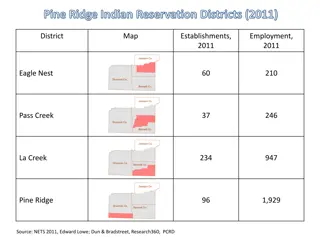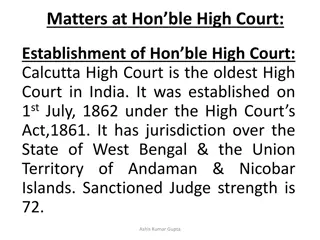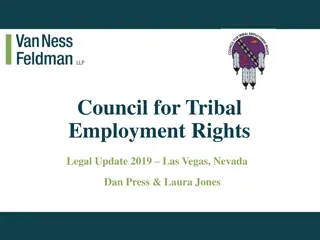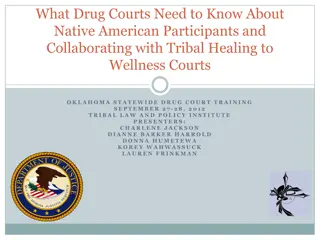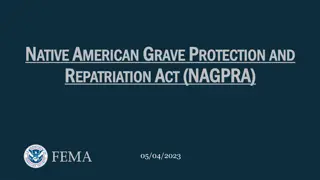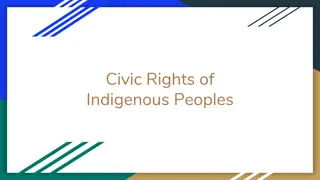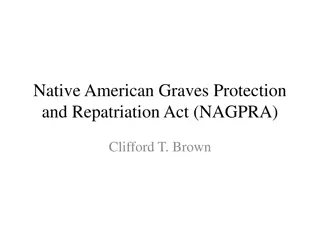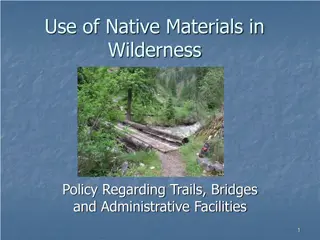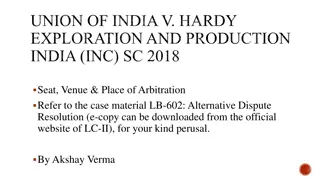Native American Reservation Policies and Jurisdiction Overview
Explore the intricate policies surrounding Native American reservations, including the authority to proclaim new reservations, tribal jurisdiction, criminal and civil jurisdiction for on-reservation and off-reservation members, specific acts of Congress governing jurisdiction, and the reservation proclamation process. Learn about the requirements, best practices, and documentation needed for reservation proclamations under the Indian Reorganization Act.
Download Presentation

Please find below an Image/Link to download the presentation.
The content on the website is provided AS IS for your information and personal use only. It may not be sold, licensed, or shared on other websites without obtaining consent from the author. Download presentation by click this link. If you encounter any issues during the download, it is possible that the publisher has removed the file from their server.
E N D
Presentation Transcript
1. Treaties 2. Executive Orders 3. Acts of Congress 4.Secretarial Orders 2
The Secretary of the Interior is hereby authorized to proclaim new Indian reservations on lands acquired pursuant to any authority conferred by this Act, or to add such lands to existing reservations: Provided, That lands added to existing reservations shall be designated for the exclusive use of Indians entitled by enrollment or by tribal membership to residence at such reservations. 3
On-Reservation Off-Reservation Members Criminal & Civil Jurisdiction ICWA (Compact) (Full Faith & Credit) Non- Member Indians Criminal Jurisdiction. Must be enrolled & have connection to reservation. NAGPRA NHPA Non- Indians General Rule: No Criminal or Civil Jurisdiction. Exceptions: Consensual Relationship with Tribe. Must threaten health, safety, & welfare of Tribe. Act of Congress. Violence Against Women Act Clean Air Act Clean Water Act 5
On-Reservation Off-Reservation Members Criminal & Civil Jurisdiction ICWA (Compact) (Full Faith & Credit) Non- Member Indians Criminal Jurisdiction. Must be enrolled & have connection to reservation. NAGPRA NHPA Non- Indians General Rule: No Criminal or Civil Jurisdiction. Exceptions: Consensual Relationship with Tribe. Must threaten health, safety, & welfare of Tribe. Act of Congress. Violence Against Women Act Clean Air Act Clean Water Act 6
New Policy- Reservation Proclamations On July 22, 2014, internal guidelines for submitting reservation Proclamation requests to Central Office was issued by the Director, BIA. 7
Reservation Proclamation Process These guidelines establish: 1. Requirements for Regional Offices 2. Best Practices 3. Required Documentation 8
New Policy- Reservation Proclamation Process Reservation proclamations can only be issued for completed trust acquisitions pursuant to IRA (25 U.S.C. 465). 9
Step 1: Tribal Request Tribe submits request to Home Agency. Request should contain: 1. Tribal Resolution 2. Legal Description/Trust Deed 3. Map 10
Step 1: Tribal Request Tribal Resolution: Cite authority for action and request proclamation Should be separate from tribal resolution requesting land into trust Can be initiated as soon as acquisition is recorded at LTRO Should state justification for the proclamation and uses for land 1. 2. 3. 4. 11
Step 1: Tribal Request Legal Description/Trust Deed: Submit copy of trust deed with land description and approval. Acreage and land description in resolution must match TAAMS Title Status Report, BILS LDR, and trust deed. If request is for portion of trust acquisition only, only include this land description in resolution. Tribal request must state that only a portion of acquisition is to be proclaimed. Multiple acquisitions that are contiguous can be submitted as one request. 1. 2. 3. 4. 12
Step 1: Tribal Request Map: Application should include a map, plot, or survey that depicts the location of the subject land in relation to the present reservation, or other trust and restricted lands. 13
Step 2: Home Agency Process Home Agency generates the following documentation for submission to Regional Office: BILS LDR Notice to State, County, and Local Governments NEPA Draft Reservation Proclamation Draft Federal Register Notice Draft Memo from Director to AS-IA Brief History of the Land Acquisition Proof of Statutory Authority for Trust Acquisition (Deed or TR) Title Status Report 10. Justification and Recommendation to Regional Director 1. 2. 3. 4. 5. 6. 7. 8. 9. 14
Step 3: Regional Office Process Regional Office reviews submission and works with agency to perfect application. 1. Once application is complete, RO drafts recommendation Memo to Director, BIA, with all documentation needed to issue proclamation. 2. 15
Step 4: Central Office Process Central Office reviews submission and works with Regional Office to perfect application. Reservation Proclamation requests are reviewed by the Solicitor. If acceptable, AS-IA signs proclamation and published notice in the Federal Register. 1. 2. 3. 16
Step 5: Recordation at LTRO Federal Register Notice should then be recorded at LTRO by Home Agency. Inform LTRO that proclamation should be encoded to TAAMS Legal Document Module (Document Class 07 - Secretarial Order). 17
Step 6: Notice to Tribe Send copy of recorded Federal Register Notice to Tribe and inform Tribe that Proclamation process is complete. 18



